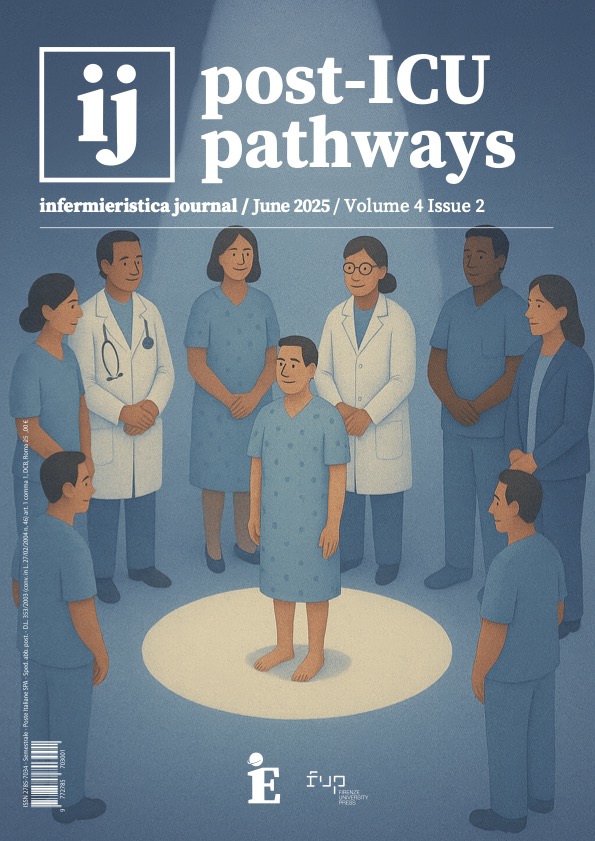Nursing Management Strategies for a Patient With an Aeson CARMAT® Total Artificial Heart: a Case Report
Published 2025-06-30 — Updated on 2025-07-15
Versions
- 2025-07-15 (2)
- 2025-06-30 (1)
Keywords
- Aeson CARMAT®,
- Total Artificial Heart,
- Nursing Care,
- Mechanical Circulatory Support,
- Heart Failure
Copyright (c) 2025 Simone Amato, Giulia Fattore , Andrea Battisti , Valentina De Bartolo, Vincenza Giordano , Niccolò Simonelli , Anna Rita Marucci, Francesco Gravante

This work is licensed under a Creative Commons Attribution 4.0 International License.
Abstract
Introduction. Total artificial heart (TAH) devices are a viable bridge to transplantation in patients with end-stage biventricular heart failure. Among these, the Aeson CARMAT® TAH offers pulsatile flow and biocompatible materials to enhance physiological compatibility and reduce thromboembolic risks.
Case Presentation. We describe the case of a 62-year-old male with ischemic cardiomyopathy and NYHA Class IV symptoms, deemed ineligible for immediate heart transplant. The patient underwent Aeson TAH implantation following multidisciplinary evaluation and was admitted to the cardiac surgery intensive care for postoperative management.
Clinical Findings. Postoperative care focused on six core areas: (1) hemodynamic monitoring, including continuous tracking of pressures and device-derived values; (2) anticoagulation and bleeding control with INR-based dosing; (3) infection prevention via strict asepsis and respiratory therapy; (4) device monitoring, including waveform interpretation and alarm management; (5) patient and caregiver education on device handling and complication signs; and (6) early mobilization to prevent ICU-related complications and support functional recovery.
Discussion. The case highlights the nurse’s central role in managing TAH patients, integrating technical competence with holistic support. Early identification of complications and structured education contributed to a successful recovery and preparation for transplant listing.
References
- Esper SA, Subramaniam K. Heart failure and mechanical circulatory support. Best Pract Res Clin Anaesthesiol. 2012;26(2):91-104. doi: https://doi.org/10.1016/j.bpa.2012.03.003
- Zhou AL, Etchill EW, Giuliano KA, et al. Bridge to transplantation from mechanical circulatory support: a narrative review. J Thorac Dis. 2021;13(12):6911-6923. doi: https://doi.org/10.21037/jtd-21-832
- Martin AC, Moussa MD, Panholzer B, et al. Initial Experience With Aeson Total Artificial Heart in Cardiogenic Shock Patients on Extracorporeal Life Support. JACC Heart Fail. doi: https://doi.org/10.1016/j.jchf.2025.01.023
- Mohacsi P, Leprince P. The CARMAT total artificial heart. Eur J Cardiothorac Surg. 2014;46(6):933-934. doi: https://doi.org/10.1093/ejcts/ezu333
- Henn MC, Mokadam NA. Total artificial heart as a bridge to transplantation. Curr Opin Organ Transplant. 2022;27(3):222-228. doi: https://doi.org/10.1097/MOT.0000000000000982
- Gagnier JJ, Kienle G, Altman DG, et al. The CARE guidelines: consensus-based clinical case reporting guideline development. Headache. 2013;53(10):1541-1547. doi: https://doi.org/10.1111/head.12246
- Schroder JN, McCartney SL, Jansen P, et al. The First Autoregulated Total Artificial Heart Implant in the United States. Ann Thorac Surg Short Rep. 2022;1(1):185-187. doi: https://doi.org/10.1016/j.atssr.2022.09.007
- Arabia FA, Copeland JG, Pavie A, Smith RG. Implantation technique for the CardioWest total artificial heart. Ann Thorac Surg. 1999;68(2):698-704. doi: https://doi.org/10.1016/s0003-4975(99)00540-8
- Hravnak M, George E. Nursing considerations for the patient with a total artificial heart. Crit Care Nurs Clin North Am. 1989;1(3):495-513.
- Pasha AK, Lee JZ, Desai H, Hashemzadeh M, Movahed MR. In-hospital complications associated with total artificial heart implantation in the United States between 2004 to 2011. Am J Cardiovasc Dis. 2022;12(5):278-282.
- Östman M, Bäck-Pettersson S, Sundler AJ, Sandvik AH. Nurses' experiences of continuity of care for patients with heart failure: A thematic analysis. J Clin Nurs. 2021;30(1-2):276-286. doi: https://doi.org/10.1111/jocn.15547
- Schweickert WD, Pohlman MC, Pohlman AS, et al. Early physical and occupational therapy in mechanically ventilated, critically ill patients: a randomised controlled trial. Lancet. 2009;373(9678):1874-1882. doi: https://doi.org/10.1016/S0140-6736(09)60658-9
- McDonagh TA, Metra M, Adamo M, et al. 2023 Focused Update of the 2021 ESC Guidelines for the diagnosis and treatment of acute and chronic heart failure. Eur Heart J. 2023;44(37):3627-3639. doi: https://doi.org/10.1093/eurheartj/ehad195
- Savarese G, Lund LH, Dahlström U, Strömberg A. Nurse-Led Heart Failure Clinics Are Associated With Reduced Mortality but Not Heart Failure Hospitalization. J Am Heart Assoc. 2019;8(10):e011737. doi: https://doi.org/10.1161/JAHA.118.011737
- Brisco MA, Testani JM, Cook JL. Renal dysfunction and chronic mechanical circulatory support: from patient selection to long-term management and prognosis. Curr Opin Cardiol. 2016;31(3):277-286. doi: https://doi.org/10.1097/HCO.0000000000000278
- Sze S, Pellicori P, Kazmi S, et al. Prevalence and Prognostic Significance of Malnutrition Using 3 Scoring Systems Among Outpatients With Heart Failure: A Comparison With Body Mass Index. JACC Heart Fail. 2018;6(6):476-486. doi: https://doi.org/10.1016/j.jchf.2018.02.018
- Heidenreich PA, Bozkurt B, Aguilar D, et al. 2022 AHA/ACC/HFSA Guideline for the Management of Heart Failure: A Report of the American College of Cardiology/American Heart Association Joint Committee on Clinical Practice Guidelines. Circulation. 2022 May 3;145(18):e1033. doi: doi: https://doi.org/10.1161/CIR.0000000000001063


